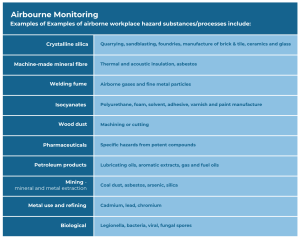What is Occupational Hygiene?
Protecting people from workplace hazards
Find out more about Latus Group’s service here www.latusgroup.co.uk/occupational-hygiene
Occupational hygiene is the discipline of protecting worker health by controlling workplace hazards. It also helps in maintaining worker well-being and safeguarding the wider community.
By using science and engineering skills the occupational hygienist will identify, evaluate and control exposure to workplace hazards that may include chemicals, dust, fumes, noise, radiation, vibration and extreme temperatures, amongst others.
“The aim is to understand workplace health risks and communicate advice on what needs to be done to prevent serious illnesses like asthma cancer, deafness, and skin disease.” – British Occupational Hygiene Society
Often the risk from health hazards present in the workplace are not obvious and can be difficult to recognise and understand. They can cause serious long-term ill-health if appropriate controls have not been applied.
Clear communication to both motivate workers and managers to act is critical in successfully managing the risks.
How important is Occupational Hygiene?
- Number of deaths due to work activities is about 250 per year
- Deaths due to road traffic accidents about 2,500 per year
- Deaths due to work-related cancer & respiratory disease estimated at 13,000 per year
There is a role for occupational hygiene within most workplaces. This is offered as a consultancy to companies involved in construction, manufacturing, mining, engineering, energy, petrochemical, and refining, to name a few.
Occupational hygiene is an applied science covering many types of hazardous agents includes:
- Toxicology and how the various hazardous agents impact on the human body.
- Measurement methods and equipment/instruments.
- Analysis of measurement results including statistical analysis.
- Evaluation of risk and any need for action to reduce exposures.
- A wide range of methods of exposure control, including engineering measures such as ventilation systems.
- Containment solutions and personal protective equipment.
- Taking account of human factors and leadership in addition to technical requirements.
A closer look
Let’s take a closer look into a few of the areas that benefit from occupational hygiene.
- Airbourne Hazards
- Noise Hazards
- Vibration
Examples of Airbourne workplace hazard substances

Process of Control with Airbourne hazards
The process of control usually starts with a desk top study gaining information upon the nature of hazards and exposure within the clients working environment.
This is usually followed by a walk-through survey which may involve the initial measurement of airborne substances (aerosols) using direct measuring equipment and photographing processes using light scattering illumination.
This is to identify where, how and who is exposed to hazardous aerosols.
This is then usually followed by a survey where the personal exposure of identified individuals to hazardous aerosols are measured through capture on filters or other appropriate media. Which is then compared to exposure standards published annually by HSE.
This will lead to recommendations for control which may be engineering or administrative.
Process of Control with Noise Hazards
Noise at work can cause temporary or permanent hearing damage that is disabling.
This can be:
- gradual, from exposure to noise over time.
- caused by sudden, extremely loud noises.
Noise at work can interfere with communications and make warnings harder to hear. It can also reduce a person’s awareness of their surroundings. These factors can lead to safety risks – putting people at risk of injury or death.
Identifying a noise problem
This will depend on how loud the noise is and how long people are exposed to it.
There is a need to do something about the noise if any of the following apply:
- the noise is intrusive-, or worse than intrusive, for most of the working day.
- employees must raise their voices to have a conversation when about 2 metres apart.
- employees use noisy powered tools or machinery for more than half an hour a day.
- The sector is one known to have noisy tasks, like aviation, quarrying, or manufacturing.
- there are noises due to impacts like hammering, drop forging or pneumatic impact tools.
- noises from explosive sources such as, cartridge-operated tools, detonators, or guns.
Situations consideration of safety issues in relation to noise include where:
- warning sounds to avoid or alert to dangerous situations are used.
- working practices rely on verbal communications.
- there is work around mobile machinery or traffic.
Hygienist activity
The hygienist will undertake an initial visit site to measure background noise levels and observe the types of exposure in the workplace along with vulnerable individuals and identify a survey strategy.
The noise survey will measure personal exposure from identified individuals and produce a noise footprint map of the site. From the data gathered, the noise risk to both individual operatives and any visitors to site will be identified.
To mitigate the risks recommendations detailing controls will be provided and a follow up of measurement of controls once implemented will be undertaken.
Control
There are many ways of reducing noise and noise exposure. It may be possible to remove the source of noise altogether – for example, housing a noisy machine where it can’t be heard by workers.
If not possible, recommendations to meet statutory requirements might be recommended such as:
- using quieter equipment or a different, quieter process.
- engineering/technical controls to reduce, at source, the noise produced by a machine or process.
- screens, barriers, enclosures & absorbent materials to reduce noise path to the people exposed.
- designing and laying out the workplace to create quiet workstations.
- improved working techniques to reduce noise levels.
- limiting the time people spend in noisy areas
Vibration
Vibration is oscillatory motion, and the human body is exposed in many occupations.
Hand-arm vibration (HAV) can be caused by:
- operating hand-held power tools, such as road breakers
- operating hand-guided equipment, such as powered lawnmowers
- holding materials being processed by hand-fed machines, such as pedestal grinders.
Occasional exposure is unlikely to cause ill health. Whole-body vibration (WBV) mainly affects drivers of vehicles used off-road, such as:
- dumpers
- excavators
- agricultural tractors
However, it can also affect drivers of some vehicles:
- used on paved surfaces, such as lift trucks.
- on rails, such as gantry cranes
Hand Arm Vibration Syndrome (HAVS)
HAVS is a painful and disabling condition that affects the nerves, blood vessels, muscles and joints of the hands and arms.
It causes tingling and numbness in the fingers, reduces grip strength and the sense of touch, and affects the blood circulation (vibration white finger, also known as VWF).
Whole-body vibration
WBV is associated mostly with low back pain, circulatory, bowel, respiratory, muscular and whole back disorders.
Measuring Vibration
The hygienists will visit site to collect data on equipment usage and measure vibration levels on unknown equipment.
Then calculate the HAV exposure or WBV exposure and compare them to the vibration exposure limits detailed in the vibration at work regulations.
Recommendations can then be made to reduce exposure by both engineering and administrative controls.
How can Latus Group help your business?
Latus offer a variety of services to cover all of your Occupational Health and Health Surveillance needs.
- Health Surveillance
- Management Referrals
- Safety Critical and Fit-For-Work Medicals
- Mental Health, Physiotherapy/MSK Clinic
- GP Support
- Workplace Testing and Screening
- Vaccinations
- Biological Monitoring
- First Aid and Mental Health First Aid Training
- Health and Wellness Screening
If you’d like to speak to us about health surveillance, visit our page and contact us with any questions.

